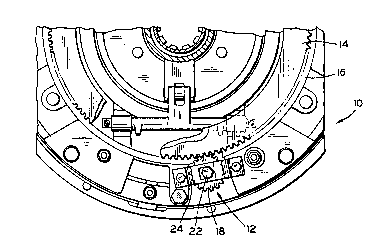Une partie des informations de ce site Web a été fournie par des sources externes. Le gouvernement du Canada n'assume aucune responsabilité concernant la précision, l'actualité ou la fiabilité des informations fournies par les sources externes. Les utilisateurs qui désirent employer cette information devraient consulter directement la source des informations. Le contenu fourni par les sources externes n'est pas assujetti aux exigences sur les langues officielles, la protection des renseignements personnels et l'accessibilité.
L'apparition de différences dans le texte et l'image des Revendications et de l'Abrégé dépend du moment auquel le document est publié. Les textes des Revendications et de l'Abrégé sont affichés :
| (12) Demande de brevet: | (11) CA 2013234 |
|---|---|
| (54) Titre français: | DISPOSITIF DE REGLAGE POUR EMBRAYAGE |
| (54) Titre anglais: | CLUTCH ADJUSTER |
| Statut: | Réputée abandonnée et au-delà du délai pour le rétablissement - en attente de la réponse à l’avis de communication rejetée |
| (51) Classification internationale des brevets (CIB): |
|
|---|---|
| (72) Inventeurs : |
|
| (73) Titulaires : |
|
| (71) Demandeurs : |
|
| (74) Agent: | SMART & BIGGAR LP |
| (74) Co-agent: | |
| (45) Délivré: | |
| (22) Date de dépôt: | 1990-03-28 |
| (41) Mise à la disponibilité du public: | 1990-09-29 |
| Licence disponible: | S.O. |
| Cédé au domaine public: | S.O. |
| (25) Langue des documents déposés: | Anglais |
| Traité de coopération en matière de brevets (PCT): | Non |
|---|
| (30) Données de priorité de la demande: | ||||||
|---|---|---|---|---|---|---|
|
Title
CLUTCH ADJUSTER
Abstract of the Invention
A clutch adjuster adapted to compensate for clutch disc wear
incorporates a spring lock which in a first position secures the
adjuster against rotation. On application of a disengagement
force, the lock is deflected to a second position, wherein the
adjuster is free for rotation. In one preferred form, the lock
has an aperture which engages a bolt head on the adjuster, and
upon application of the force the lock is axially displaced from
the bolt head. In a second preferred form, a disc spring is
adapted to normally retain the bolt head axially away from a
clutch cover in a first, secured, position. Upon application of
force, the bolt head is depressed against the disc spring to
shift the adjuster to a second position wherein the bolt head is
free for rotation.
2734APP
Note : Les revendications sont présentées dans la langue officielle dans laquelle elles ont été soumises.
Note : Les descriptions sont présentées dans la langue officielle dans laquelle elles ont été soumises.

2024-08-01 : Dans le cadre de la transition vers les Brevets de nouvelle génération (BNG), la base de données sur les brevets canadiens (BDBC) contient désormais un Historique d'événement plus détaillé, qui reproduit le Journal des événements de notre nouvelle solution interne.
Veuillez noter que les événements débutant par « Inactive : » se réfèrent à des événements qui ne sont plus utilisés dans notre nouvelle solution interne.
Pour une meilleure compréhension de l'état de la demande ou brevet qui figure sur cette page, la rubrique Mise en garde , et les descriptions de Brevet , Historique d'événement , Taxes périodiques et Historique des paiements devraient être consultées.
| Description | Date |
|---|---|
| Le délai pour l'annulation est expiré | 1994-09-28 |
| Demande non rétablie avant l'échéance | 1994-09-28 |
| Réputée abandonnée - omission de répondre à un avis sur les taxes pour le maintien en état | 1994-03-28 |
| Inactive : Demande ad hoc documentée | 1994-03-28 |
| Demande publiée (accessible au public) | 1990-09-29 |
| Date d'abandonnement | Raison | Date de rétablissement |
|---|---|---|
| 1994-03-28 |
Les titulaires actuels et antérieures au dossier sont affichés en ordre alphabétique.
| Titulaires actuels au dossier |
|---|
| DANA CORPORATION |
| Titulaires antérieures au dossier |
|---|
| PATRICK M. SULLIVAN |
| RICHARD A. FLOTOW |